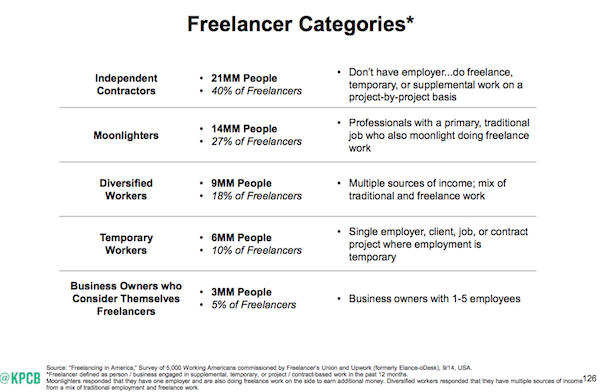Mary Meeker’s latest report on Internet trends was recently released. While many observers are pondering the some of the big stats relating to the size of the digital economy and the big companies that stand to benefit, I was interested in a data point that pretty much slipped beneath the radar. Buried on page 126 of Meeker’s slideshow was this finding, relating to freelancers:
Freelancers = Significant & Growing Portion of Workers @ 53MM People, 34% of USA Workforce
She broke down the numbers further, relying on data from oDesk/Upwork:
If these numbers are correct, it represents a huge change in the way Americans are working. Certainly, the data shows that freelancers are ready for virtual work, if tens of millions are already doing it.
But are companies ready? The slide did not break out the telecommuting workforce. Millions work from home on a full-time or part-time basis for employers located elsewhere (ranging from across town to the other side of the globe). But it’s a drop in the bucket, compared to the numbers of people who could be telecommuters if their companies allowed it.
As author Melanie Pinola pointed out in her book The Successful Virtual Office In 30 Minutes: Best practices, tools, and setup tips for your home office, coworking space, or mobile office, most jobs that take place in front of a computer screen are candidates for being done remotely. But not all companies are on board. She cited the example of Yahoo, which killed its teleworking program in 2012 because its new CEO thought collaboration and innovation were suffering.
As Melanie noted, “Good collaboration and innovation don’t require you to be within touching distance of your coworker.” If companies have the right team in place, and the right tools, telecommuters can not only be productive, they can successfully collaborate and innovate, too. Melanie’s book covers many of the tools and best practices that can help a virtual team — as well as individual contributors, their managers, and their freelance partners — operate at peak efficiency. She has also written Virtual Office Action Plans, which describes strategies and approaches for telecommuters, freelancers, and business managers.
